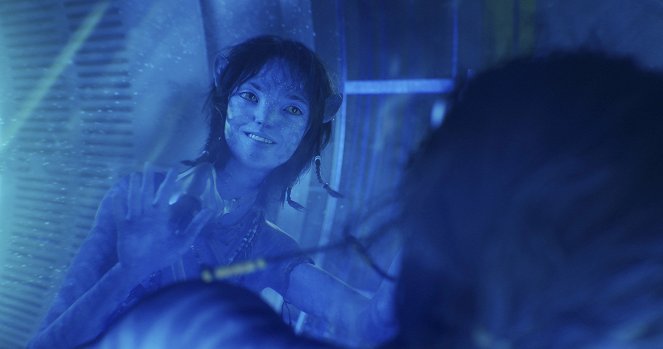Rendező:
James CameronOperatőr:
Russell CarpenterZeneszerző:
Simon FranglenSzereplők:
Sam Worthington, Zoe Saldana, Sigourney Weaver, Stephen Lang, Kate Winslet, Cliff Curtis, Joel David Moore, CCH Pounder, Edie Falco, Brendan Cowell (több)Streaming (3)
Tartalmak(1)
Az Avatar - A víz útja több mint egy évtizeddel az első rész eseményeit követően meséli el a Sully család (Jake, Neytiri és gyermekeik) történetét; a rájuk leselkedő veszélyeket, az életben maradásért vívott harcaikat, az őket sújtó tragédiákat és azt, meddig képesek elmenni, hogy biztonságban tudhassák egymást. (Fórum Hungary)
Videók (20)
Recenziók (11)
Egy átlagos tévésorozat forgatókönyve, amely nem siet sehova. A történet ismét egy rövid mondatban foglalható össze, de ráadásul ugyanaz, mint legutóbb, és úgy néz ki, hogy a következő alkalommal sem lesz másképp. A kék gyíkok természetellenes mozgása a szárazföldön a "Bemutató" óta nem változott. A film felének ezért olyan a hatása, mint egy videojáték demónak. Áthelyezés a víz alá azonban nagyszerű fejlesztés. A gyíkok sokkal szebben úsznak, mint ahogy járnak és ugrálnak, James Cameron pedig soha nem látott életet lehelt a kitalált víz alatti állatokba és növényvilágba. Gyönyörű és varázslatos! Luc Besson örülni fog. Az emberi karakterek is helyet kapnak a vízen, ami a digitális művészetnek már-már fizikai jelleget kölcsönöz. Az összes tengeralattjáró, mechanikus rákok és általában a vagány "bálnavadász" jelenetek nagyon menők. A Waterworld - Vízivilág filmben látható akciós jelenekre emlékeztetnek. De összességében az Avatar-jelenség inkább egy vidámparki attrakcióvá válik (a VV jövő ígéretével), mint a szó valódi értelmében vett filmes remekművé. Egyfajta Cameron-féle Marvel, gyengén kidolgozott karakterekkel. Ami egy kicsit kár.
()
Less water, man, less water! I’m still a big fan of the first Avatar, which worked like a euphoric trip through another world thanks to its simple narrative structure involving a hero/outsider savior of the noble savages. The second one is essentially a drawn-out and shaky soap opera about a family run by a militant father who moves to a new ’hood and can’t get used to it. Let’s leave aside that Cameron paid significantly less attention to dramatic motivations than he did to the last fish below the surface. The whole film thus seems irrational and the dialogue, which was never Avatar’s strength, is even more ear-scratchingly pedantic. As an epic tech reel, however, the film is breathtaking and I truly, royally enjoyed the underwater National Geographic in HFR. There is something truly intoxicating in the smoothness and fluidity. Unfortunately, the film’s 192 minutes are emotionally stolen by a crippled humpback whale, which has the significant advantage that it doesn’t talk (and even its retrospective is not told smoothly). Yes, Cameron is a great craftsman and illusionist, but as a storyteller, he fails here significantly in my opinion. There is no development of the mythology to speak of, as everything is just a variation, the metaphor of nature as a loving entity is becoming more and more naïve and, honestly, I would like to spend less time waiting for the third one and the fire people after this aquatherapy. During the screening, I found it difficult to push away the thought that I would have preferred to enjoy some top-quality sci-fi, which Avatar decidedly isn’t!
()
I like how every plot shift is tied to familial relationships (as family comprises the whole ecosystem of Pandora in this case), how the film works superbly with parallels (between the characters’ relationships and the past and present – the villain goes through the same initiation as Jake in the first film, but with a different result) and how divine the water and underwater CGI looks, and I’m not offended by the simple eco-friendly plot about finding a home and saving one’s family through a connection to an ancestral heritage, but Cameron is far too enamoured with his moon/planet and his singing whales, and he revels in both of these aspects far more than is necessary for the narrative. You can imagine the middle part of the film, which is followed by the comparatively interminable final act, as a sequel to My Octopus Teacher, with big fish instead of octopuses (which I don't mean as a compliment). Whereas the first Avatar flew by quickly and, due to its focus on building a fictional world and evoking fear for its fate, you weren’t bothered by the two-dimensional characters communicating through poorly written dialogue, here I felt every minute passing by, missing the mark emotionally by several nautical miles, because when the going gets tough, you will probably have trouble even remembering the name of the character whose life is at stake. At least the protagonist’s sons are similar to each other and interchangeable in terms of character. An unbearably long three hours. P.S. Some of the action scenes in 3D and 48fps look like cut scenes from a highly advanced video game (which is not a compliment either) and the non-action scenes are reminiscent of a soap opera. 60%
()
James Cameron once again shows Hollywood who is the king of blockbuster movies. Despite its three-hour running time, Avatar 2 is entertaining from beginning to end, with breathtaking audiovisual and personal stories of old and new heroes at the ideal pace. Pandora is perhaps even more beautiful than last time, the newcomers are likeable, and Cameron keeps the pace from start to finish without a single flinch. And after thirteen years, he shows that he's still a long way ahead of most Hollywood filmmakers.
()
What is the recipe for the success of Cameron’s films? As in the case of Pixar’s top projects and all of Hayao Miyazaki’s movies, there is no secret to it; on the contrary, it is banally uncomplicated, though not simple or obvious. Cameron creates fantasy worlds with the ambition to maximise the viewers’ immersion in them and he achieves this by being absolutely demanding and making no comprises. Cameron’s essential asset as a master director is his complete understanding of the technological possibilities of the medium and his ability to push those possibilities in a visionary way. But what receives little emphasis is the fact that Cameron subordinates to this immersion not only the demands of executing the special effects, but primarily his formalistic signature. He doesn’t create money shots, fool around with the camerawork or editing, show off with flashy long shots or otherwise let the film exhibit itself to the audience. When he goes for a slow-motion shot, he does so in the interest of working with the dynamics and build-up of the whole sequence, not with the aim of making a cool picture. That doesn’t mean that he doesn’t set challenges for himself. His films contain a lot of difficult shots and each of his projects is actually a major campaign with the objective of conquering new territory for cinema as a medium of illusion. But, again, all efforts remain subordinate to the audience’s immersion in the given world he has created. This maxim also guarantees that the narrative isn’t cluttered with anything that would break the fourth wall, whether references nodding at fans or characters and artefacts that serve only as intrusive advertisements for associated merch. Unlike Star Wars and the Marvel movies, Cameron’s films don’t offer corporate-calculated webs of stories that would lend themselves to fandom fetishisation. Instead, Cameron simply creates fictional worlds that entice viewers with their fantastical nature and the promise of their settings and characters. Cameron himself says that his screenwriting process comes from two directions. On the one hand, there are the characters and their relationships. On the other hand, there are the specific scenes and settings that Cameron would like to see. Writing the screenplay then involves coming up with motivations and peripeteias that connect these two pillars causally and logically. Then, of course, there is Cameron’s own imagination, which shapes the particular worlds. And that’s all; there is nothing else behind his success (well, except for effective PR, which in turn relies on the potential that Cameron creates). It then invites further reflection on what it says about the state of blockbusters and Hollywood as a whole when the above is not the norm but a celebrated anomaly. ______ In light of the above, the only weakness of Cameron’s films is his screenplays. Or perhaps it’s only the perspective of viewers who aren’t completely captivated by them. Compared to the first Avatar, the narrative shifts in the sequel may not sit well with some viewers. Conversely, some will be irritated by the excessive similarity between the two films and the repetition of motifs. Still others will have an issue with the apparent lapses in logic (even if they are transgressions against the opinions of the respective viewers and not against the rules of fiction). Other people won’t be able to get past the wall of their own cynicism and accept the new-age environmental ethos, naïve mythmaking, post-colonial romanticism or Cameron’s characteristic melodrama. Personally, I was saddened mainly by the evoked impression that I had already seen several times. For one thing, Cameron again builds on the first film’s love story with the story of a family on the run and a coming-of-age motif, just as he did with Terminator 2. The story of parental love that turns into anxious criticalness and the necessity of giving adolescents their freedom regardless of what mistakes they make as a result because they can grow only by making those mistakes fortunately remains universal and fundamental enough not to seem derivative. Furthermore, its likable in that it irritates the parents in the audience and appeals greatly to younger viewers. Apart from that, however, memories of key sequences in Titanic and The Abyss inevitably creep into one’s mind at particular moments in the film. On the other hand, the idea that Cameron is merely ripping himself off can be quickly dispelled by recalling the work of George Miller, who also works with variations on certain motifs in the Mad Max films. Cameron also uses similar situations simply because he likes them, knows their dramatic potential and enjoys recreating them. ______ After all, personal passion and imprinting one’s signature on a film are essential attributes of a director’s work. Cameron most clearly projects into his films his often mentioned fascination with strong women and warrior mothers, as well as his fascination with the undersea world. With respect to the latter, the second Avatar is perhaps his most inward-looking project since The Abyss. In multiple storylines, he expresses the desire to merge with that alien world which is so close, actually within reach, but the limits of the human body constantly make its strangeness and unattainability felt.
()
(kevesebbet)
(több)
Galéria (81)
Photo © Walt Disney Studios Motion Pictures







Hirdetés